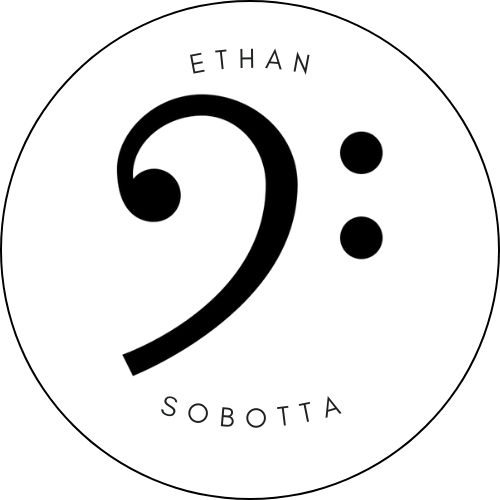Instruments Basics (No, I won’t make that pun.)
To work regularly, a theater bassist needs to be able to double on both electric and upright bass, and there will typically be the need to play both arco & pizzicato on the latter. In the grand scheme of shows, the distribution for me has been about 50/50, upright/electric. The classic Broadway shows up to the 1960s will obviously be all upright, while electric begins making its appearance in the late ‘60s with shows like Hair. Barring throwback/retro shows like The Drowsy Chaperone, most modern scores are either all electric or call for a mix of both electric and upright.
UPRIGHT BASSES & BOWS
My main upright is a circa-1890s Tyrolean 3/4 carved bass with a C extension made by Seattle-area luthier Sarah Balmforth. This is the bass I use if A) the show is all/mostly upright, B) there are lots of notes below E, and/or C) I have the luxury of having a protected section of the pit/stage. For pizz-focused shows, I string it with a set of Pirastro Perpetuals (with the stark D & G); for more arco-heavy books, I’ll swap the D & G with Pirastro Flexocor Deluxes for a variation on Edgar Meyer’s Spirocore E-A/Permanent D-G setup.
The other upright I use regularly is a 5/8 Shen SB-150 hybrid. This is what I will bring if the pit is cramped or if the bass seat is more exposed to through traffic. This bass wears Perpetuals full-time.
I have also occasionally used a plywood bass if the score calls for the “old American plywood” Kay/King/American Standard sound with a lot of ‘50s rock & roll or slap-style playing. (All Shook Up is a good example of this.) My current instrument for this is a 1938 Kay M4 wearing Pirastro Evah Pirazzi Slaps.
For bows, I end up going with my Carbow carbon fiber Grunberger-model French bow most of the time due to its sound and durability. At heart, I am a German bow player, and used a Reid Hudson for most of my professional career, primarily for orchestra work. As I don’t do as much of that type of work these days, I have decided to trade the Reid in for a bow by German maker Steffen Kuhnla, and have been very pleased with the results. It is his “shop” model, but Steffen doesn’t do “seconds,” so the line between his shop and master bows is very blurry.
ELECTRIC BASSES
Modern scores call almost exclusively for 5 string bass. Even if a show doesn’t specifically request it, that’s usually what I’ll bring, either because the orchestrator sneaks in some notes below E, or because taking stuff down the octave is just fun. My main 5 is a Sadowsky Metroline 5 string JJ, strung with Sadowsy Blue Label stainless steel roundwounds.
If a really vintage sound is desired (think Company or Pippin), I may bring my 1971 Fender Precision, strung with Thomastik Jazz Flats.
Some shows (most notable lately is Hamilton) may call for a hollowbody bass; if so, I use a Lakland Hollowbody (34” scale version) strung with LaBella 760FL Deep Talkin’ Flats.
MICROPHONES/PICKUPS
I keep this setup pretty simple. The Ear Trumpet Labs Nadine is my favorite upright-specific mic. I have found the small-diaphragm condensers that are frequently used to have an annoyingly-honky upper midrange to my ears.
For the past few years, my pickup of choice has been the Gage Realist Lifeline.
I usually like to blend the mic and pickup together, and absolutely love the Grace Design Felix 2 preamp for this.
AMPLIFICATION
It’s about 50/50 on whether I need an amp for any given show these days. If we are on in-ears, it’s likely I’ll be going direct. When an amp is needed, my favorite is the Phil Jones BG-450. It’s small but powerful, and the 450 lops about 20 lbs. off of the original BG-400.
DI & PEDALS
I won’t go into great detail on every pedal I use in this post, but the ones I find myself regularly putting on the board are:
DI: Caveman Audio BP1 Compact Bass Preamp/DI or Tech 21 VT Bass DI
DRIVE/DISTORTION: I like the Way Huge Pork & Pickle overdrive/fuzz lately due to its versatility.
OCTAVE: Either an MXR Vintage Bass Octave or my vintage ‘80s BOSS OC-2, depending on the sound I’m going for.
